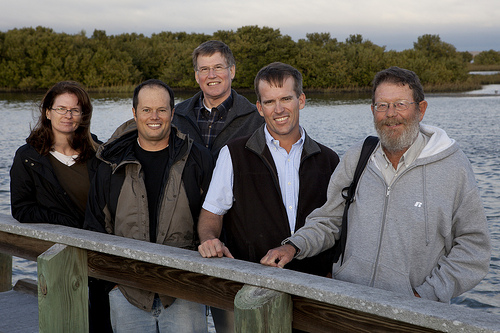Florida Sea Grant is currently funding research that is the first in the southeastern U.S. to adapt the forerunner of new fisheries models to grouper populations off Florida’s Gulf of Mexico coast.

From left, Sherry Larkin, Bill Pine, Bill Lindberg, lead researcher Mike Allen, and Carl Waters make up the grouper fishery modeling team. UF/IFAS photo.
The Ecopath modeling software suite generates powerful computer simulations that could help fisheries managers better estimate the size of grouper, snapper and other reef fish populations.
Managers currently depend on single-species models, but the Ecopath suite brings a multi-species capability that allows scientists to better calculate direct and indirect effects from a multitude of factors in the ocean environment.
In this case, the project team is particularly focused on exploring how regulations influence the value of the valuable grouper fishery as well as reef fish diversity.
Using this approach may help fishery managers, commercial fishermen and recreational fishermen understand how tradeoffs in the value of recreational and commercial fisheries can be balanced with the need for healthy reef ecosystems.
“Groupers represent some of the most valuable fisheries in the Gulf of Mexico,” says lead researcher Mike Allen, a professor of fisheries at the University of Florida. “However, regulations put in place to protect grouper could have influences on red snapper and the rest of the reef fish community. Fisheries managers need tools to explore how management actions can influence both the economic value of fisheries and the health of reef ecosystems.”
A portion of the project has entailed customizing the model to more accurately reflect neighboring species, environmental conditions, human fishing effort, and existing management controls for the grouper fishery in the Gulf.
At a recent workshop organized by cooperating researchers Dave Chagaris and Behzad Mahmoudi at the Florida Fish and Wildlife Conservation Commission, fisheries managers and representatives from commercial and recreational fishing groups worked with the model to examine its ease of use, and explored its potential as a management tool.
“What we have now is the ability to highlight the types of tradeoffs we’re going to encounter when we’re simultaneously trying to maximize our economic and ecological goals for grouper,” Allen says. “The next step will be to begin the process of incorporating it into the complex stock assessment process.”



